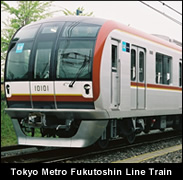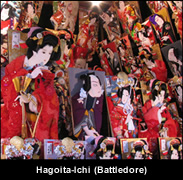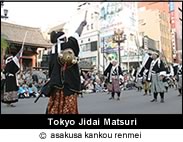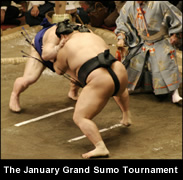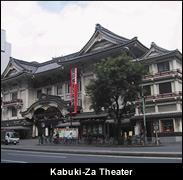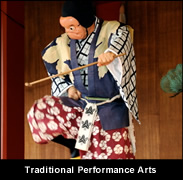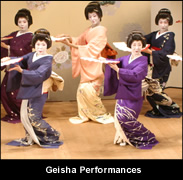 |
 |
 |
 |
 |
 |
 |
 |
 |
   |
- News & Announcements
- Event Information
- Featured Event - January Grand Sumo Tournament
- Featured Theme - Nightlife Theatre
- Featured Theme - Nightlife Geisha
- Online Resources - Tokyo Trends
|
 |
|
Tokyo is an official Olympic Candidate City!
Tokyo was selected as an official Candidate City for the XXXI Olympic and Paralympic Games by the IOC in Athens, Greece on June 4th. Already a world-class destination, Tokyo is transforming itself into an iconic 21st Century metropolis in hopeful preparation to host the world’s greatest event in 2016.
http://www.tokyo2016.or.jp/en/
Even more international visitors to Tokyo!
The number of international visitors to Tokyo reached 5,330,000 in 2007 which is a 10.9% increase over 2006.
Royal Park Hotel - English Support for Nihombashi
As part of the Royal Park Hotel's effort to make it easier for visitors to enjoy Nihombashi's old Edo downtown atmosphere, the hotel has created a "gourmet dining guide" in English to go with the "bilingual menus" now available at many of the eating and drinking establishments in the Nihombashi area.
Tokyo Metro Fukutoshin Line
Tokyo Metro's latest line opened on June 14th and runs from Wako-shi in Saitama via Ikebukuro to Shibuya, conveniently making stops in Ikebukuro, Shinjuku, and Meiji-Jingumae (Harajuku). Express trains between Shibuya and Ikebukuro will only take 11 minutes.
http://www.tokyometro.jp/fukutoshin/#/top (Japanese)
|
|
|
 |
|
* The event information below has been collected for about six months from now to better facilitate tour planning.
Dream Yosacoy Festival
November 01 & 02 (Odaiba to Ariake)
Teams from all over Japan will present various performing shows in colorful costumes during this two-day event. Both festival days end with a free-for-all dance performance.
http://www.dreamyosacoy.jp/ (Japanese)
http://www.tourism.metro.tokyo.jp/english/tourists/
topics_event/topics/071101/2.html (article from 2007)
Tokyo Jidai Matsuri
November 03 (Sensoji Temple, Asakusa)
A parade, performed in traditional costume, to recognize the capital's evolution from the Edo era to the present.
http://www.e-asakusa.jp/event/0611_jidai_e.html (article from 2006)
Hagoita-Ichi (Battledore)
December 17 to 19 (Sensoji Temple, Asakusa)
Some 50 stalls enthusiastically sell ornamental good-luck charms such as hagoita (battledore), shuttlecocks, and kites during this annual fair.
http://www.jnto.go.jp/eng/indepth/history/traditionalevents/a65_fes_hagoita.html
Kokyo Ippan Sanga
January 2, 2009 (Imperial Palace Grounds)
One of only two days when Imperial Palace grounds are open to the public and where visitors can catch a glimpse of the Imperial Family. Entrance to the gardens is by Nijubashi Bridge.
Antique Jamboree
January 9 – 11, 2009 (Tokyo Big Sight, Odaiba)
Over 500 dealers sell a range of Japanese and foreign antiques at one of the biggest antique shows in Japan.
http://home.att.ne.jp/sun/jambokun/antique/e.html
Illumination Events
Tokyo's winter season will be brighter than ever as illumination displays decorate city centers. Below are two of the more popular events:
Roppongi Hills Artelligent Christmas
Dates: Middle of Nov. - Dec. 25
Access: Tokyo Metro Roppongi Station
Roppongi Keyakizaka Street and Mori Garden are among the areas illuminated by lights.
http://www.roppongihills.com/en/monthly_event/2007_12.html (article from 2007)
http://tokyo.360cities.net/fs.html?loc=roppongi-hills-christmas.p36
Shinjuku Southern Lights
Dates: Middle of Nov to Middle of Feb.
Access: JR Shinjuku Station
The illumination displays sit on the Shinjuku Southern Terrace walkway next to the massive Takashimaya department store.
Other illumination locations can be found at:
http://www.japan-guide.com/e/e2303.html |
|
|
 |
|
January Grand Sumo Tournament
January 11 to 25, 2009 (Kokugikan Sumo Hall, Ryogoku)
Sumo is one of Japan’s most well-known sports. Physically demanding but also deceptively complex, sumo features over 70 varieties of throws, tricks, forms and trips – all steeped in rituals and traditions that stretch back centuries. As a spectator sport, sumo offers patrons a fascinating glimpse of Japanese traditional culture and an unparalleled sporting experience. Three of the six annual Grand Tournaments are held right here in Tokyo in January, September and May. It’s a day out in Tokyo like no other!
Further Information:
http://www.sumo.or.jp/eng/ |
|
|
 |
Tokyo offers visitors the chance to enjoy many of Japan's classic performing arts. From Noh and Kyogen to Bunraku and Kabuki, live shows are staged at a number of venues throughout the city. Some of Tokyo's most popular theatres are listed below.
Kabuki-za
(Higashi-Ginza Station, Tokyo Metro Hibiya and Toei Asakusa Lines)
Since 1889 Kabuki-za has been one of Tokyo's main theatres for Kabuki performances. Regular ticket are usually available from 17,000 yen to 2,500 yen depending on the proximity to the stage and an English earphone guide service is available for an additional fee. Kabuki-za also offers a special "Makumi" or single act ticket for around 1,000 yen. Visitors interested in "Makumi" tickets must line up for the tickets prior to the performance they wish to see.
http://www.kabuki-za.co.jp/ (Japanese)
http://www.kabuki-za.co.jp/english/program.html
National Theatre of Japan
(Hanzomon Station, Hanzomon Line or Nagatacho Station, Yurakucho & Namboku Lines)
The National Theatre of Japan complex stages traditional Japanese performing arts in three performance halls.
The "Large Theatre" is used for Kabuki, Buyo (Japanese traditional dance), Minzoku Geino (folk performing arts), and Gagaku (Japanese court music) performances.
The "Small Theatre" hosts Bunraku (traditional puppet theatre), Kabuki, Buyo, Hogaku (Japanese traditional music), and Minzoku Geino. While the smaller "National Engei Hall" stages Yose (Rakugo story-telling, Manzai comedy)
http://www.ntj.jac.go.jp/english/index.html
National Noh Theatre
(Sendagaya Station, JR Chuo/Sobu Lines or Kokuritsu Kyogijo Station, Oedo LIne)
Since 1983 The National Noh Theatre has been presenting classical Noh and its accompanying comic drama form Kyogen.
http://www.tcvb.or.jp/en/infomation/7recom/wt9.html
http://www.jnto.go.jp/eng/arrange/attractions/facilities/
museums/83dn3a000000ef81.html
For more information on Japanese performing arts, please check out the following links:
An introduction to Kabuki:
http://www2.ntj.jac.go.jp/unesco/kabuki/en/
An introduction to Bunraku:
http://www2.ntj.jac.go.jp/unesco/bunraku/en/
An introduction to Noh & Kyogen:
http://www2.ntj.jac.go.jp/unesco/noh/en/
|
|
|
 |
|
Geisha in Tokyo
Contrary to popular thought, if you are hoping to see Geisha while in Japan, you do not have to travel to Kyoto. There were historically numerous Geisha districts in Tokyo, and these classic artisans can still be found practicing in certain areas of Japan’s bustling modern capital.
Where to go
Asakusa
Behind the Sensoji Temple, this district is home to one of the biggest Geisha towns in Tokyo. Here you might see Geisha slipping into a Chaya (teahouse or restaurant) in the evening and hear the sounds of shamisen (Japanese lute) and tsuzumi (Japanese drums).
Mukojima
Located east of the Sumida River, Mukojima is Tokyo's largest Geisha district and has housed Geisha quarters for almost 300 years. Many Chaya are still active in the area.
Kagurazaka
Hundreds of Geisha used to entertain businessmen and politicians in this area. The Kagurazaka district is perhaps the closest you will get to a glimpse into old Edo (Tokyo). Ryotei (Geisha houses) still operate along the narrow stone-paved alleys.
For more information on Kagurazaka Geisha, please email:
info@ikimachi.co.jp
General Performances
Sadachiyo Ryokan offers an "Asakusa Geisha Odori Course".
http://www.sadachiyo.co.jp/e/eindex.html
|
|
|
 |
|
1. Web Japan
Sponsored by the Japanese Ministry of Foreign Affairs (MOFA), Web Japan covers the latest trends in Japan and even hosts interesting videos and a great kids' section.
http://web-japan.org/
2. Tokyo Street Style
What is Tokyo wearing? The Japan Fashion Association keeps you updated with an abundance of great photos.
http://www.style-arena.jp/index_e.htm |
|
|
 |
 |
 |
| |
To access the previous edition of e-Tokyo Today and our printed newsletter, Tokyo Today,
please visit: http://www.tourism.metro.tokyo.jp/english/citypromotion/index.html.
If you wish to stop receiving this newsletter, please send an email to news@tcvb.or.jp titled, "Unsubscribe".
Issued by: Tourism Division, Bureau of Industrial and Labor Affairs, Tokyo Metropolitan Government
Planning / Editing: Tokyo Convention & Visitors Bureau
E-mail: news@tcvb.or.jp Tel: +81-3-5840-8892 Fax: +81-3-5840-8895. |
|
|


